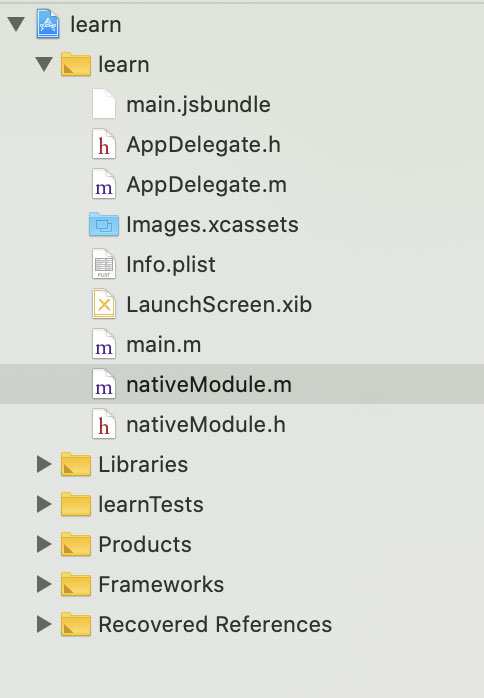您好,登錄后才能下訂單哦!
您好,登錄后才能下訂單哦!
這篇文章給大家分享的是有關React Native與IOS端之間交互的示例分析的內容。小編覺得挺實用的,因此分享給大家做個參考,一起跟隨小編過來看看吧。
首先最好了解一點關于 oc 的語法知識
1.創建聲明文件nativeModule.h
#import <Foundation/Foundation.h> #import <React/RCTBridgeModule.h> @interface nativeModule : NSObject <RCTBridgeModule> @end
2.創建文件nativeModule.m
#import <Foundation/Foundation.h> #import "nativeModule.h" @interface nativeModule () @end @implementation nativeModule @end

這是添加完文件后的結構目錄
關于 interface 的區別:
.h里面的@interface,它是供其它Class調用的。它的@property和functions,都能夠被其它Class“看到”(public)
而.m里面的@interface,在OC里叫作Class Extension,是.h文件中@interface的補充。但是.m文件里的@interface,對外是不開放的,只在.m文件里可見(private)
因此,我們將對外開放的方法、變量放到.h文件中,而將不想要對外開放的變量放到.m文件中(.m文件的方法可以不聲明,直接用)。
在 .m 文件中添加方法:
// 省略上面的代碼
@implementation nativeModule
// 這句代碼是必須的 用來導出 module, 這樣才能在 RN 中訪問 nativeModule這個 module
RCT_EXPORT_MODULE();
// 接收字符串
RCT_EXPORT_METHOD(addHelloWord:(NSString *)name location:(NSString *)location)
{
NSLog(@"%@,%@", name, location);
}
@endRN 代碼:
import { Button, NativeModules } from 'react-native'
const { nativeModule } = NativeModules
<Button title={'傳 2 個參數給 native'} onPress={() => {
nativeModule.addHelloWord('你的名字', '位置:浙江')
}}/>點擊此按鈕的作用,就是將 '你的名字', '位置:浙江' 這 2 個字符串傳遞到了原生端
在 .m 文件中添加:
// 只接受一個參數——傳遞給 JavaScript 回調函數的參數數組。
RCT_EXPORT_METHOD(checkIsRoot:(RCTResponseSenderBlock)callback) {
NSArray *array = @[@"string", @"number"];
callback(array);
}在 RN 中添加代碼:
<Button title={'js 傳一個回調給 native,回調中收到一個數組'} onPress={() => {
nativeModule.checkIsRoot((str: string, num: string) => {
console.log(str, num)
})
}}/>這是在 RN 中 給原生端傳遞了一個回調函數,用來解決,部分操作完成后的回調, ** 如果 callback 多次調用 RN 會報錯 **
在 .m 文件中添加代碼:
@interface nativeModule ()
@property (nonatomic) RCTPromiseResolveBlock normalResolve;
@property (nonatomic) RCTPromiseRejectBlock normalReject;
@property (nonatomic) NSInteger num;
@end
// 這是一個計時器
-(void)startTime: (NSArray*) data{
NSTimer *timer = [NSTimer scheduledTimerWithTimeInterval:2 repeats:YES block:^(NSTimer * _Nonnull timer) {
NSArray *events =@[@"Promise ",@"test ",@" array"];
if (events) {
self.normalResolve(events);
[timer invalidate];
} else {
[timer invalidate];
NSError *error=[NSError errorWithDomain:@"我是回調錯誤信息..." code:101 userInfo:nil];
self.normalReject(@"no_events", @"There were no events", error);
}
}];
[[NSRunLoop mainRunLoop] addTimer:timer forMode:NSDefaultRunLoopMode];
}
// 回調給RN的參數,回調的錯誤信息
RCT_EXPORT_METHOD(getHBDeviceUniqueID: (RCTPromiseResolveBlock)resolve
rejecter:(RCTPromiseRejectBlock)reject) {
// 要執行的任務
self.normalResolve = resolve;
self.normalReject = reject;
[self performSelectorOnMainThread:@selector(startTime:) withObject: [NSArray arrayWithObjects: @"1", @"2", nil] waitUntilDone:YES];
}在 RN 中添加代碼:
<Button title={'native傳一個 promise 給 JS'} onPress={() => {
nativeModule.getHBDeviceUniqueID().then((arr: string[]) => {
console.log('resolve', arr)
}).catch((err: string) => {
console.error(err)
})
}}/>nativeModule.getHBDeviceUniqueID 的執行他是一個 promise,可以獲取原生端的回調, 其實和方法 2 差不多
在 .m 文件中添加:
// 這是一個計時器2
-(void)startTime2: (NSArray*) data{
NSLog(@"data%@",data);
NSTimer *timer = [NSTimer scheduledTimerWithTimeInterval:1 repeats:YES block:^(NSTimer * _Nonnull timer) {
NSLog(@"%d", (int)self.num);
self.num = self.num + 1;
NSLog(@"%d", (int)self.num);
if (self.num > 4) {
[timer invalidate];
NSLog(@"end");
self.normalResolve(data);
}
}];
[[NSRunLoop mainRunLoop] addTimer:timer forMode:NSDefaultRunLoopMode];
}
// RCT_REMAP_METHOD 與RCT_EXPORT_METHOD相同,但是該方法是在JS線程上從JS同步調用的,可能會返回結果。
// 同步可能會有性能問題 建議除了 promise 以外都別使用
RCT_REMAP_METHOD(findEvents,
findEventsWithResolver:(RCTPromiseResolveBlock)resolve
rejecter:(RCTPromiseRejectBlock)reject)
{
self.normalResolve = resolve;
self.normalReject = reject;
self.num = 0;
[self performSelectorOnMainThread:@selector(startTime2:) withObject: [NSArray arrayWithObjects: @"1", @"2", nil] waitUntilDone:YES];
}在 RN 端添加代碼:
<Button title={'native傳一個 promise 給 JS2'} onPress={() => {
nativeModule.findEvents().then((arr: string[]) => {
console.log('resolve', arr)
}).catch((err: string) => {
console.error(err)
})
}}/>方法 4 和方法 3 大體一致,但是有一點不同,就是 RCT_REMAP_METHOD 使用此方法會將代碼變成同步狀態
在 appDelegate.m 文件中添加代碼:
NSArray *imageList = @[@"http://foo.com/bar1.png",
@"http://foo.com/bar2.png"];
NSDictionary *props = @{@"images" : imageList};
RCTRootView *rootView = [[RCTRootView alloc] initWithBridge:bridge moduleName:@"learn" initialProperties:props];
// 這一行代碼原本就有,不同點在于 initialProperties:props在 RN 端寫入:
// 重寫 APP , images就是 iOS 提供的數據,這里我們通過 context 來傳遞數據
export default class App extends React.Component<{ images: string[] }> {
render() {
return <NativeProps.Provider value={this.props.images}>
<AppContainer/>
</NativeProps.Provider>
}
}
// 在 hooks 里簡單的使用
const images = useContext(NativeProps);
<Text>這是從 native 端傳來的初始數據{JSON.stringify(images)}</Text>在 .m 文件中添加代碼:
// 可供監聽的事件名稱
- (NSArray<NSString *> *)supportedEvents
{
return @[@"EventReminder"];
}
RCT_EXPORT_METHOD(postNotificationEvent:(NSString *)name)
{
NSLog(@"calendarEventReminderReceived");
[self sendEventWithName:@"EventReminder" body:@{@"name": name}];;
}
- (void)calendarEventReminderReceived:(NSNotification *)notification
{
// 這是官網的例子
NSLog(@"calendarEventReminderReceived");
NSString *eventName = notification.userInfo[@"name"];
[self sendEventWithName:@"EventReminder" body:@{@"name": eventName}];
}
RCT_EXPORT_METHOD(Send){
NSDictionary *dict = @{@"name" : @"veuimyzi"};
NSNotification *notification = [[NSNotification alloc] initWithName:@"EventReminder" object:nil userInfo:dict] ;
[self calendarEventReminderReceived:notification];
}在 RN 中添加代碼:
const ManagerEmitter = new NativeEventEmitter(nativeModule)
const [msg, setMsg] = useState([])
// hooks 中的使用,類似于 componentDidMount 生命周期
useEffect(() => {
const subscription = ManagerEmitter.addListener(
'EventReminder',
(reminder) => {
setMsg(prevState => {
return prevState.concat(reminder.name)
})
console.log('這是監聽的EventReminder事件回復', reminder.name)
}
)
return () => {
subscription.remove()
}
}, [])
<Button title={'js 監聽事件,讓 native 給 js 發通知'} onPress={() => {
nativeModule.postNotificationEvent('test')
}}/>
<Button title={'js 監聽事件,讓 native 給 js 發通知 send'} onPress={() => {
nativeModule.Send()
}}/>
{
msg.map((item, index) => {
return <Text key={item + index}>item:{item}</Text>
})
}關于 postNotificationEvent 方法是屬于最簡單的使用, 在原生端調用 sendEventWithName 就可以傳遞數據給 RN 的監聽
而另一個方法 Send 和 calendarEventReminderReceived ,一個是來自于官網的實例 講的是從 NSNotification獲取數據, Send 是傳遞數據給 calendarEventReminderReceived
關于監聽的優化, 這個官網上也有,有空可以看下,就是在 .m 文件中添加下列代碼:
@implementation nativeModule
{
bool hasListeners;
// 一個局部變量
}
-(void)startObserving {
hasListeners = YES;
}
-(void)stopObserving {
hasListeners = NO;
}
// 在發送監聽的添加判斷,如果有監聽才發送,有效減少橋接代碼的調用
if (hasListeners) {
[self sendEventWithName:@"EventReminder" body:@{@"name": name}];;
}感謝各位的閱讀!關于“React Native與IOS端之間交互的示例分析”這篇文章就分享到這里了,希望以上內容可以對大家有一定的幫助,讓大家可以學到更多知識,如果覺得文章不錯,可以把它分享出去讓更多的人看到吧!
免責聲明:本站發布的內容(圖片、視頻和文字)以原創、轉載和分享為主,文章觀點不代表本網站立場,如果涉及侵權請聯系站長郵箱:is@yisu.com進行舉報,并提供相關證據,一經查實,將立刻刪除涉嫌侵權內容。